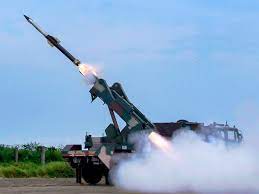Quick Reaction Surface To Air Missile (QRSAM):

India conducted six successful flight-tests of the Quick Reaction Surface to Air Missile (QRSAM) system from Integrated Test Range (ITR) Chandipur off the Odisha coast.
- The test was jointly conducted by the Defence Research and Development Organisation (DRDO) and Indian Army.
- QRSAM is a canister-based system, which means that it is stored and operated from specially designed compartments.
- In the canister, the inside environment is controlled, thus along with making its transport and storage easier, the shelf life of weapons also improves significantly.
- The system is capable of detecting and tracking targets on the move and engaging targets with short halts.
- It is a short-range surface-to-air missile (SAM) system, primarily designed and developed by DRDO to provide a protective shield to moving armoured columns of the Army from enemy aerial attacks.
- The entire weapon system has been configured on a mobile and manoeuvrable platform and is capable of providing air defence on the move.
- It has been designed for induction into the Army and has a range of 25 to 30 km.
- The QRSAM weapon ensemble, which functions on the move, consists of a fully automated command and control system.
- It also consists of two radars – Active Array Battery Surveillance Radar and Active Array Battery Multifunction Radar – with one launcher.
- Both radars have 360-degree coverage with “search on move” and “track on move” capabilities.
- The system is compact, uses a single stage solid propelled missile and has a mid-course inertial navigation system with two-way data link and terminal active seeker developed indigenously by DRDO.




